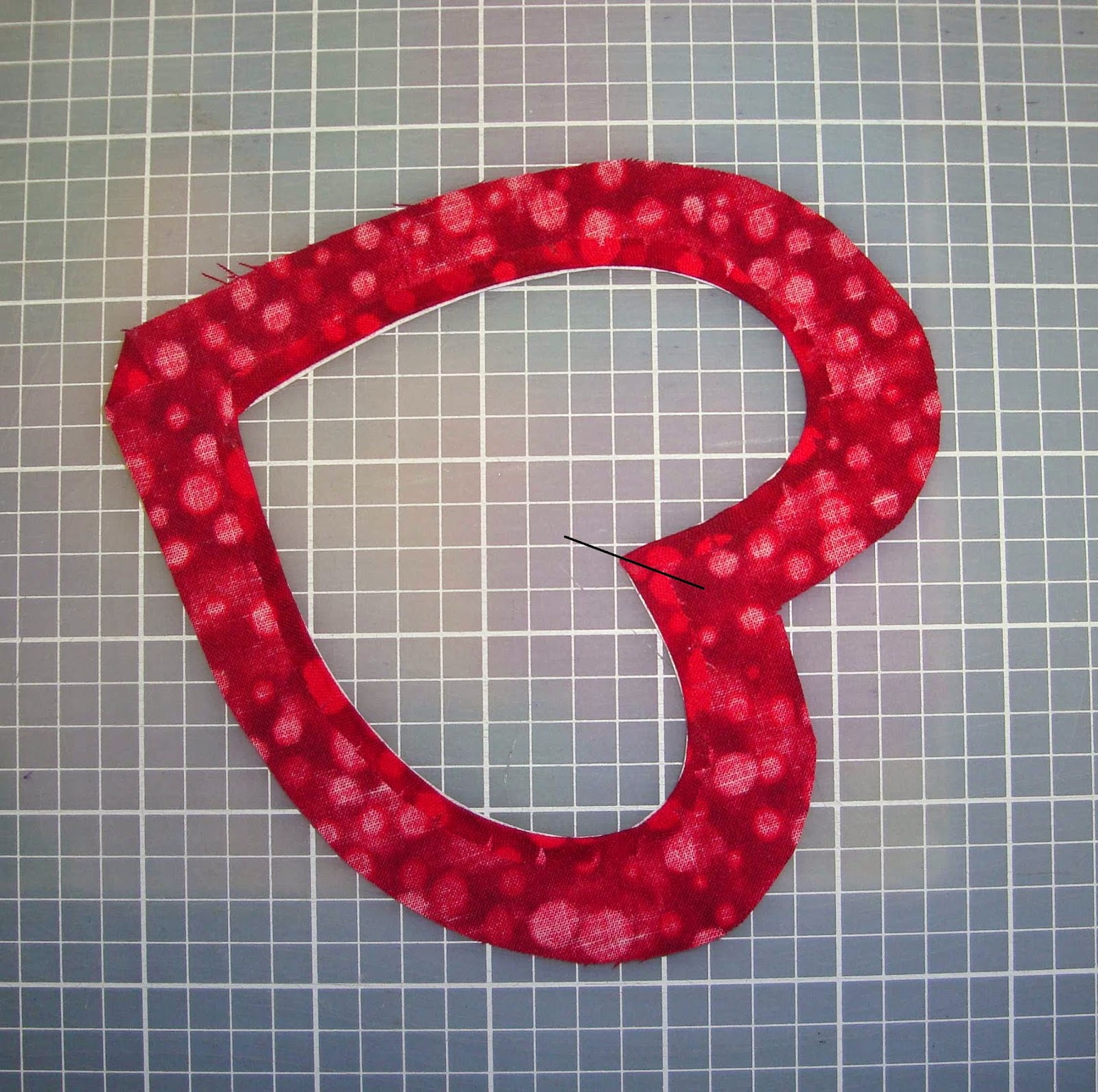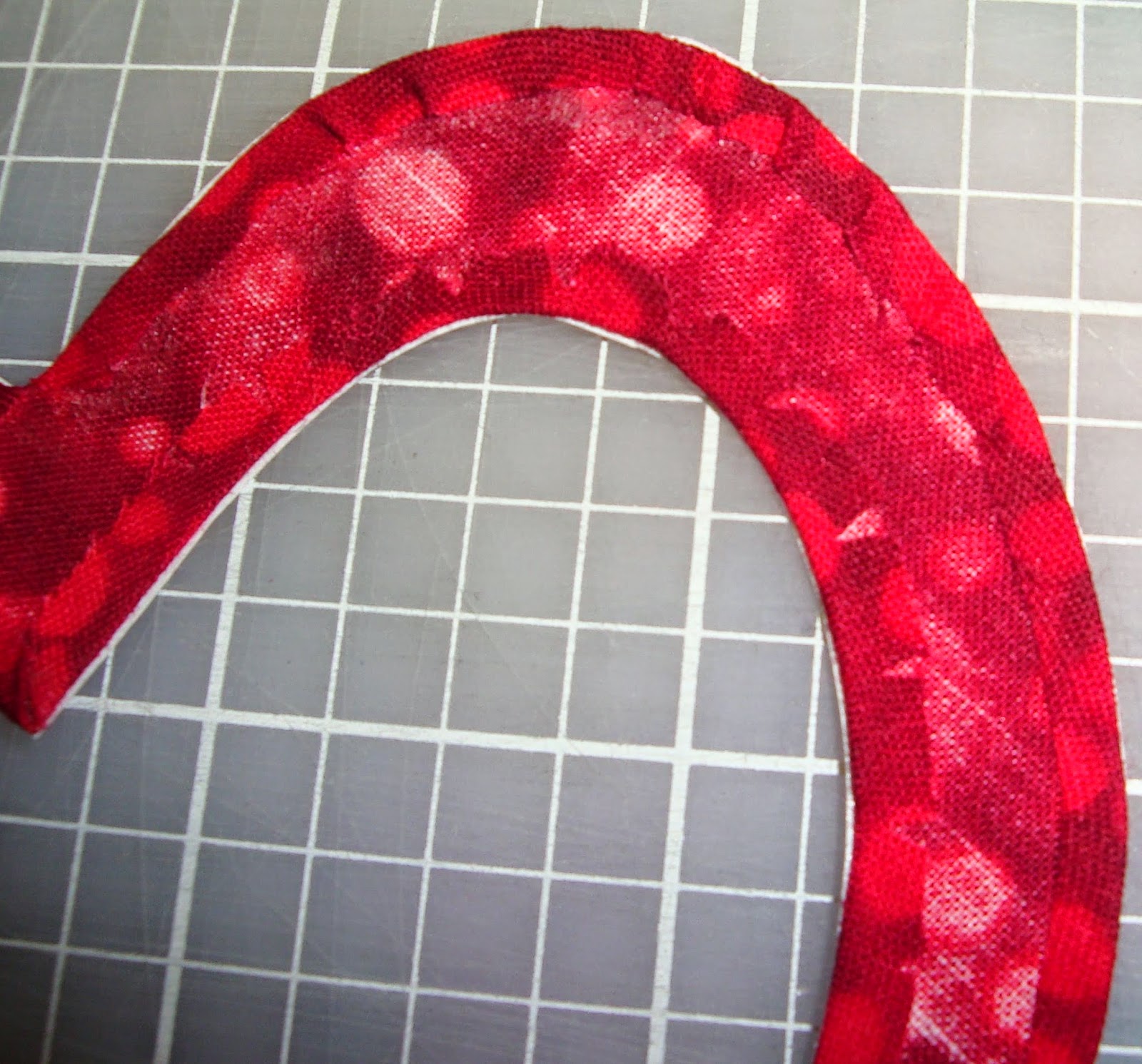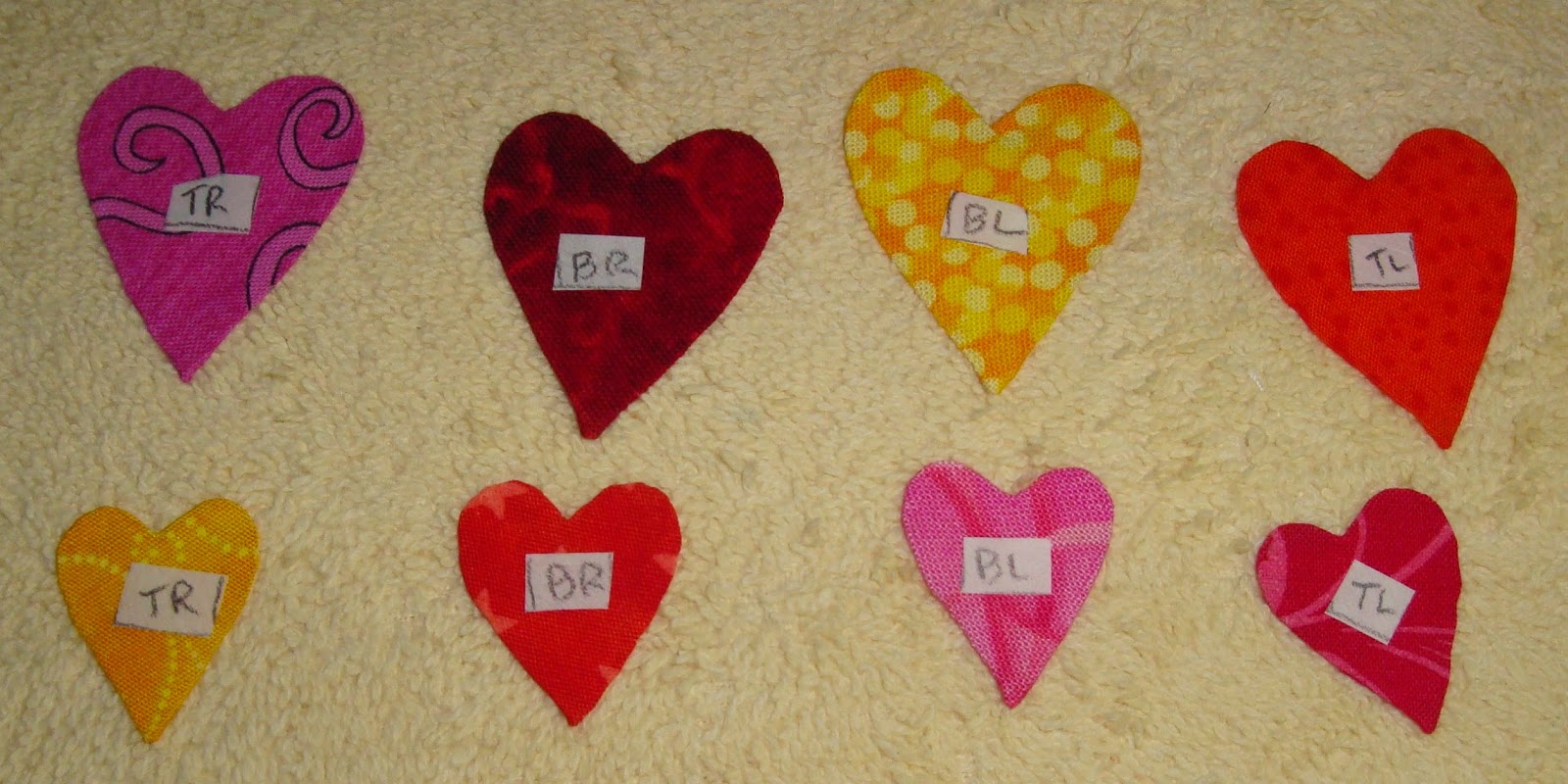Welcome to the big reveal for "QUILTMAKER'S 100 BLOCKS,
Vol. 10." I am so pleased and proud to have had a block chosen for this edition! My block is called "Tangled Hearts" and is block #912 on page 23. It is now available where quilt magazines are sold.

I am a hand applique ADDICT and have started to design my own unique projects...check out my side bar for my "Baltimore Rhapsody - Symphony" music applique project. I am also an organizing whack job when it comes to my "quilt cave" and stash, and I love scrappy piecing and applique projects (I hate narrowing down fabric choices for projects, so I USE EVERYTHING!).
At the end of this post, you will have an opportunity to enter into a give-away for a copy of this new magazine to be sent from QUILTMAKER and for one of three quilty prizes from me...a total of four fun prizes for 4 lucky who leave comments. In addition, I will announce the winners of my premature "blunder giveaway" of last week.
But first, the block tutorial!
This block calls for 8 tangled, appliqued hearts. The color palette can be anything that strikes your fancy and the method of applique can be of your choosing, hand or machine, turned under or raw edge.
.JPG)
I decided to work from my bright scraps in red, pink, orange and yellow.

I like to do hand applique using a method I will describe in detail in this post, in case you would like to try it. I love the speed, ease and flexibility of this method.
I use the following tools: (numbers correspond to picture below)
1) freezer paper (butcher paper)
2) nice, sharp scissors for fabric and regular snips for paper
3) a stiletto (also called awl - I like the one made by Clover)
4) an Elmer's "disappearing purple" glue stick
5) a small, washable surface to work on (an acrylic ruler or
small cutting mat works great - the excess glue stick will
wash off with warm water)
6) Roxanne's Glue Baste or Elmer's Washable School Glue
7) long handled tweezers, optional (I like using these to handle
all the fiddly paper and fabric pieces)
8) pattern weights, optional (usually the glue will stick well if
you just hold it for a few seconds, but I find these helpful)
9) a pencil
10) a "Fast Turn" (smallest), optional - these are THE BEST
THING to clean out the needle tip of the glue (they can be
purchased here from P3 Designs)
.JPG)
Find Pattern Sheet #2 in the pull-out section of the magazine. There you will find heart shapes B, C and D.
Using a pencil, trace the heart shapes on the freezer paper...eight of heart B, four of heart C, and four of heart D...on the non-shiny side of the paper. Here are the eight heart B shapes on eight bright scraps. Press them on the RIGHT side of the fabric scrap with a hot, dry iron, making sure there is a small margin all the way around. The shiny side of the freezer paper will adhere until peeled away.
I numbered each heart pattern so that I would remember the order later on when arranging the 8 prepped hearts.
Using the sharp scissors, cut out each heart, inside and out, leaving an 1/8 inch allowance (or 3/16 inch - the skinnier the allowance, the smoother and less bulky the outer curves).
If you are doing raw-edge or machine applique, no allowance is needed and you probably want to use a light-weight fusible instead of the freezer paper, adhered to the WRONG side of your fabric.
Now I will show you how I prepare the pieces for hand applique.
One at a time, turn the hearts wrong-side-up on a washable surface. I usually use a seldom used acrylic ruler, but they were too shiny for taking photos, so I am using a small cutting mat here.
Working on the edge of the glue stick...
...dab a little glue on the two points indicated below. The "disappearing purple" shows up a little bit on the red fabric (it is much more visible on lighter fabrics - the purple is temporary).
Using the awl, I fold the points over until I just see the white paper pattern point (that is pressed on the other side). The white pattern will always be my guide as I glue the edges over on the wrong side of the fabric.
I like the stiletto because the sharp point helps me to grab and fold the fabric over.
Before gluing under the edges, I need to use my sharp scissors to make a single cut (a snip) at each of the INSIDE corners (see below). Because these are sharp corners, I cut all the way to the edge of the paper pattern.
Before gluing the inside curves, I make additional little snips with my scissors. These will be much more shallow that the ones made at corners...the depth and the frequency has to do with how deeply curvy the area is where I am gluing...where the curve is deeper, the cut is a little deeper and more frequent. This keeps the piece flat as the edges are glued under.
The arrows below show where I cut, and the following pictures show the depth and frequency. Once the edge is glued, it will be easier to see where I made my snips.
When gluing each inside edge, I will fold under at the inside apex to the point of the line drawn below (each side folds in, half way, to meet in the middle and make a nice point).
I use the very edge of my white paper pattern as a guide as I glue.
It is a little hard to see, but I try and show the snips below (I circled a couple of them).
As the curve gets deeper, the snip goes deeper, as shown by the inserted lines parallel to the edge as shown below.
Then I do the same with the other inside curve. The point at the inside apex of the heart is crisp (see below at the the arrow tip).
And the inside curve at the bottom snip goes all the way to the paper.
Now I glue the outside edge. Make no snips here! Here I make little pleats as I go. I pull the edge over with the stiletto in my dominant hand and press with the index finger of my other hand, looking for the first sight of the edge of the white pattern as my guide (my pressing index finger is not in the following photo because it is holding the camera).
Since I already glued the tip over, when I fold the other two glued edges I get a nice point (I call this a tri-fold - I also do this on the tips of leaves).
This orange heart makes it easier to see the nice, crisp point.
As I work and the surface I am working on gets sticky from the glue stick, it is easy to wash and dry the ruler or surface, then get back to work.
The purple glue stick shows up a little better on this yellow heart.
The FINISHED size of the block will be twelve inches. I started with a 14 inch block. I always use a larger block for applique, then trim the block to working size (12-1/2 inches) after I've hand stitched, soaked out the glues, pressed the piece flat, flat, flat. Then I use it in my project and the finished size is 12 inches square.
Freezer paper can be used to label pieces...just a tiny scrap of freezer paper as a label pressed on the right side of each piece can eliminate confusion.
There are a few choices of how to proceed with the layout of the prepped heart rings. If I am making more than one of a particular applique block, I like to draw a template on tracing paper. It is a little more trouble, but worth it for multiple, completely identical blocks. I do it in pencil first, then go over it in ink (ultra-fine Sharpie marker) when I am sure it is accurate and correct.
Or, I at minimum draw up a template with lines drawn up-and-down, side-to-side, and on the diagonals, as below.
At the very least, you could fold and lightly press the background to reveal the same guiding lines that I drew above.
The center of each heart will line up over each of these 8 lines, and the distance between the bottom, inner-most points of opposite hearts is 1-1/2 inches.
I am working over a light box (if you don't have a light box you can open up an Ott light under a large, square acrylic ruler).
I will wait and cut open each heart as I work around the ring of hearts.
Above, I show how I will cut the heart rings open in a place where the cut is centered over the heart to the right.
The Quiltmaker editors put a dotted line on the pattern to indicate where to cut, but I cut as I go so I make absolutely sure I cut in the right place for it to be hidden!
First, I lay out the hearts in the order that is pleasing BEFORE I cut them open and tangle them up! Below, they are in place, but not woven together.
One at a time, I will cut, weave, and glue baste the hearts to the background. I use TINY dots of glue ("dot-dot, not-a-lot") to glue baste the pieces to the background. Below, I am holding up the edges of the piece with my clumsy fingers, but I prefer to work with my long beading tweezers.
Here I have placed my glue dots, but I don't stick the red heart down until I've enclosed the yellow heart.
The pattern weights hold things in place while I pull things up to apply the tiny drops of glue.
Once the ring of hearts is in place and glue-basted, I prep the smaller heart accents. Again, I use my dry iron to press the freezer paper patterns to scraps of yellow, orange, pink and red on the right side of the fabric. Then I cut each one out leaving a 1/8 inch margin.
After I glue the edges under, I remove the freezer paper pattern and replace it with a tiny freezer paper tag so I can keep up with where each heart will go (top right, TR, etc).
Then I glue baste the little hearts into place, centering them on the diagonal lines that are either lightly pressed into the background or drawn on the tracing paper template, if I took the time to make the deluxe lay-out template.
After the glue is dry enough to be secure, I use the stiletto to pry up the edge of the pressed labels...
...then I use my tweezers to remove them!
Now I am ready to hand applique all the edges down using silk thread and my best invisible stitches. The glue baste allows me to do this without annoying pins catching my thread. Here is my block, all ready to start stitching!
After I do all the hand stitching, I soak the block in warm water with some gentle squeezing and multiple water changes to remove the glues. I use archival glue, with no acid, but I still prefer to remove the slight stiffness of the glues.
Then I place the block on a clean towel, roll it up, and squeeze gently (DO NOT WRING!). After the block mostly air-dries, I press it, right-side-down, on a dry towel. Once pressed, the block can be trimmed down to 12-1/2 inches.
Here is the block done in Reproduction fabrics.
And now, THE GIVE-AWAY!! On Thursday morning, November 20 at 6:00 AM, I will use a random number generator to pick 4 lucky winners from among the people who leave a comment on this post and follow my blog. Quiltmaker will send out one copy of this fabulous, new publication and I will send out 3 quilty surprise bags of applique-related goodies (no anonymous bloggers, please...). All winners will be revealed in a post on Thursday, November 20.
And now for my BLUNDER GIVE-AWAY from last Monday. (It's a long story...I posted this post a week early and needed to take it down, but not before there were commenters! How embarrassing!)
1) Karen of Quilts, Etc. blog
2) Teresa in Music City of A Quilt and a Prayer blog
3) Judy Dietrich
4) Janet
5) Nancy of Tattered Garden Quilts blog
Congratulations to these winners and good luck to the ones will be revealed on Thursday!
I hope you will all try this method of applique!
Check out other block designers this week by visiting the Quiltmaker Blog and following the links! I am grateful to the nice people at Quiltmaker for this opportunity to publish a block!
In stitches,
Teresa :o)










.JPG)

.JPG)






































































